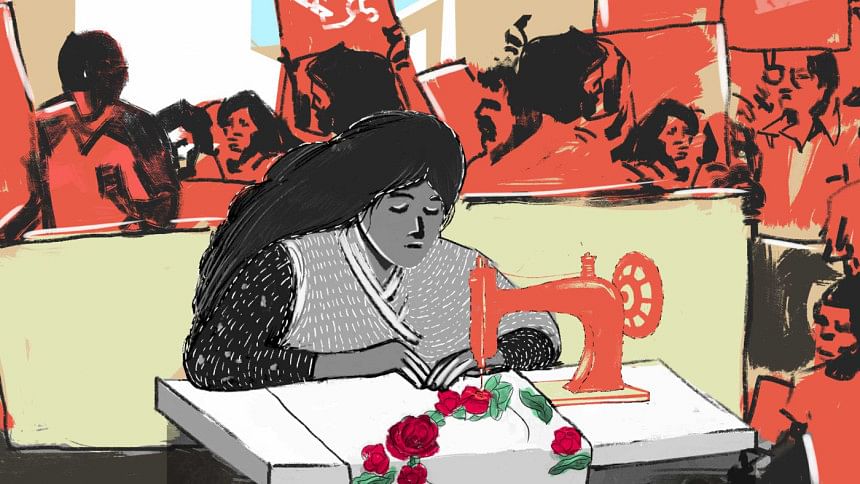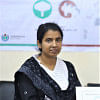When will we hear stories of workers’ lives truly improving?

This year's May Day, now in its 136th year, follows the golden jubilee of Bangladesh's independence. Since our independence, the success of Bangladesh's garments sector has featured repeatedly and prominently in national and international forums. Since the beginning of the year, various reports have lauded the significant increase in export earnings and the industry turning around post-Covid. During the first six months of the fiscal year 2021-22, readymade garments from Bangladesh worth USD 19.9 billion. These success stories are based on data from the Export Development Bureau (EPB). There is no doubt that the development of the garments sector is desirable for everyone in the country, including the workers, because it involves the question of the livelihood of four million of them. But there is no telling how much of its impact has reached the lives of the country's RMG workers. Therefore, as a labour activist, I feel it is important to explore the "success" of the garments sector in light of the struggles and condition of the workers on May Day.
Some call the current boost in the garment sector's export a miracle, some call it a big leap, some say that the wind is blowing in this sector—at least that is how the sector is being praised by the government's ministerial figures, the BGMEA leadership and the media. In 1971, Bangladesh was called a "bottomless basket" by US Ambassador U Alexis Johnson and Secretary of State Henry Kissinger. At present, the current BGMEA president is marking this particular period of export growth as a "basket full of wonders". The question that comes to mind is: for whom is this "basket full of wonders, "the owners, the government or the workers? Unfortunately, we don't see the inclusion of workers in these success stories, whose quality of life as "cheap labourers", earning a meagre Tk 8,000, remains the same as before, if not worse. The worker, whose labour is helping the economy to flourish, is unable to survive with his/her family given the current market conditions, where the prices of essentials have long spiralled out of control.
However, whenever the workers' organisations demand an increase in wages—to Tk 20,000 in light of the current inflation—the owners are enraged. They want to ignore this demand and downplay their own profits, citing a rise in prices of raw materials and other commodities. There are always such arguments in store.
Around 3,00,000 workers lost their jobs during the Covid-19 pandemic; many factories were closed down, orders worth USD 3 billion were cancelled, and tens of thousands of workers were denied their full wages and benefits. The situation was somewhat resolved when a large portion of the orders returned. Many workers who lost their jobs also got back to work. But their incomes in their new jobs decreased, as many, desperate for an income, were forced to take up entry level jobs. When government officials and private sector employees were working from the safety of their homes during the pandemic, it was the garments workers who risked their lives to, apparently, "keep the economy floating". Ensuring social distance or safety was just a luxury.
Although RMG export orders bounced back once the corona situation improved, the workers' lives did not improve. The working hours in the factories increased, as did the production pressure. An amendment to the labour law now allows four hours of overtime instead of two. One-hundred-thirty-six years ago, workers in Chicago, USA, fought to demand an eight-hour workday. However, garments workers in Bangladesh today are forced to work 12-14 hours per day to save their lives and their jobs. May Day is officially a holiday, but most of the time the workers don't get necessary holidays, even weekends. Workers suffer from various illnesses due to work pressure, in silence, for fear of losing their jobs. It is the workers who are sticking their necks out, but the owners are counting the profits.
The country's export earnings have increased in the first six months of the financial year 2021-22 and will increase in the future as well. In the first six months of FY2021-22, Bangladesh exported USD 19.9 billion worth of garments to the rest of the world. It was USD 15.545 billion in the same period during the previous year. Therefore, exports increased by 28 percent. Exports increased by 46 percent to America, 26 percent to Canada and the most to Europe. The boundaries of these markets have been widened to Chile, China, Japan, India, Australia, Brazil, Mexico, Turkey, South Africa and Russia. In the last six months, food prices have increased several times. The price of rice, lentil, eggs, sugar, oil, vegetables and other essential commodities have increased to such an extent that it has become impossible for the workers to cope with. Transportation costs have increased; LPG gas prices, and the prices of gas and water are on the rise. As a result, the house rent of the workers, transportation fares, education of their children, and medical expenses have all increased. Under the circumstances, they are struggling to simply survive in the absence of decent wages.
Meanwhile, are the factories any safer for them? On April 24, nine years after the Rana Plaza collapse, a report titled "The Story of Rana Plaza's Tragedy and Turnaround" was published in the daily Samakal. The report begins with the phrase: "The ready-made garment trade is now in a state of flux". It also says that almost every month, the previous month's export earnings record is being broken. On the other hand, the BGMEA president mentioned, "Garment factories are not only safer now, but also more dynamic, energy efficient and environmentally-friendly." We have seen some changes in factory infrastructure since the Rana Plaza tragedy as a result of the Accord and Alliance, which did substantial work to ensure building safety and security.
Every year after the death of 1,175 workers at Rana Plaza, the owners have claimed that the factory environment has improved and the damage to the country's image has been undone. But even if that's the case, the question arises, without a proper law to compensate the dead and injured workers, without ensuring that the guilty are punished, can it be said that this sector has progressed simply because of the development of buildings? Is worker's safety only related to the infrastructure, bricks and mortar? Is it also not related to the workers' right to live and earn living wages, and to organise for better conditions?
About four million workers are currently employed in the garments sector, and another 10 million are involved in this sector indirectly. Women make up a big chunk of the labour force. At one time, 80 percent of the sector was comprised of women, but according to a study by Mapped in Bangladesh, the percentage of women today is only 58 percent. As is well known, women workers do not even get time to rest after their 12-14 hours work shifts as they must look after their children and take care of household work. In the factories, they don't have adequate day-care or breast-feeding facilities, lunch, or recourse in case they face sexual harassment. They don't get a chance—and/or are not given the opportunity—to develop their skills, which is why they are less likely to be seen in senior or managerial positions. As such, they are the ones falling behind as automation takes over in the age of the 4th Industrial Revolution.
The BGMEA president wrote, in an article on 50 years of independence, that in this patriarchal society, the garment sector has brought about a revolution by increasing the income and decision-making power of women. He added, "As of today, around 4 million people are directly and another 10 million are indirectly dependent on this sector for their lives and livelihood. Among this huge workforce, around 2.5 million are women. For a male-dominated country like Bangladesh, where decision-making power usually comes with the earning capability, the RMG sector has brought a revolution here. The job gives them ample opportunity to enjoy the taste of economic freedom and liberty, which, in terms, act as a catalyst behind the overall economic and social development." The question is: if that is the case, why is the number of women workers declining? Why aren't women adapting as well to automation? Is a worker who has no minimum control over her own wage or life, who has no luxury to dream, has no money in her pocket to provide nutritious food to her own children, really free to read, to protest, or to understand her rights?
As we observe May Day, the clothing sector has stepped into the era of increased automation from manual machines. A second generation of entrepreneurs in the garments sector have begun to take the reins. This includes highly educated children of entrepreneurs or owners, who have returned from abroad, under the age of 45. To strengthen their bond, the young owners' class has created a new organisation called Bangladesh Apparel Youth Leaders Association (BAYLA).
On the other hand, many of the second-generation workers are between the ages of 30 and 35. Even at a young age, they have become worn out from work pressure. At the prime of their life, they have already become ghosts of themselves, deprived of rights and privileges. Their malnourished faces are a testimony to their plight.
The second-generation owners are using various strategies to keep themselves organised. Similarly, there is no other way for the workers of the garments sector to turn around and improve the quality of their own lives than to create strong bonds and movements. In order to change the standard of living, we have to unite for wage increases, security and the right to organise. The current political climate of fear and lack of democracy in the country has to be questioned. The RMG success story cannot be restricted to owners only, but must extend to the workers. Only then will the industry truly thrive.
Taslima Akhter is photographer and president, Bangladesh Garment Workers Solidarity.
The article was translated from Bangla by Kazi Akib Bin Asad.

 For all latest news, follow The Daily Star's Google News channel.
For all latest news, follow The Daily Star's Google News channel. 



Comments